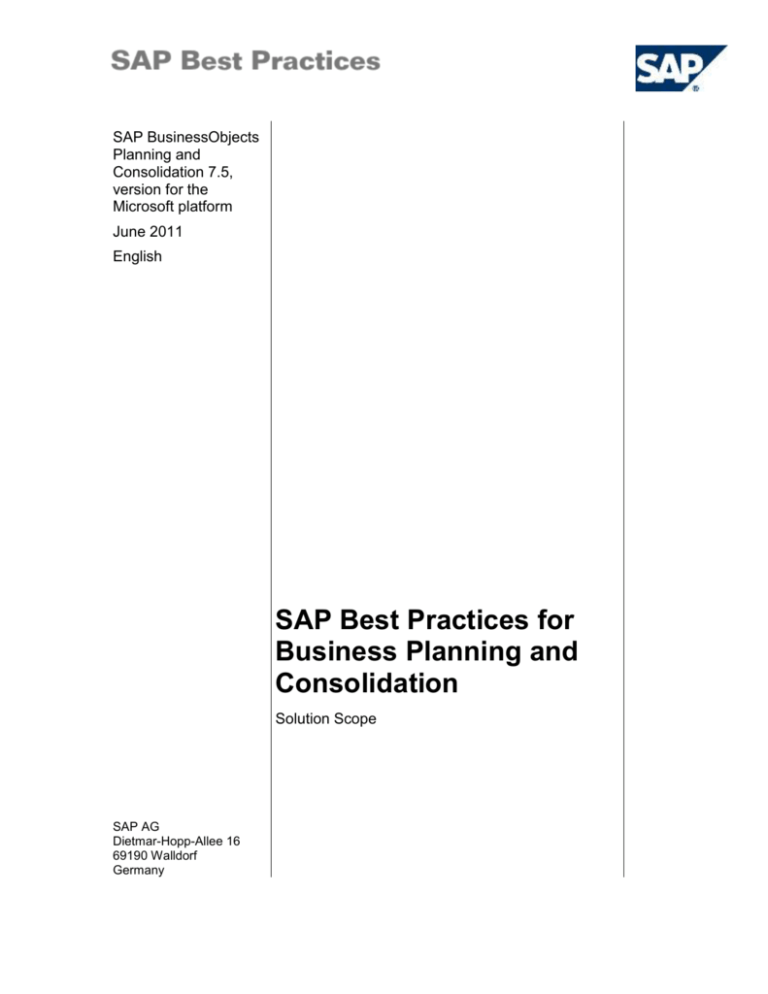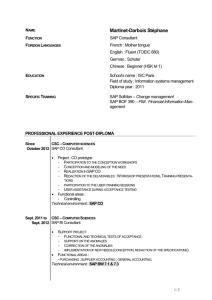
SAP BusinessObjects
Planning and
Consolidation 7.5,
version for the
Microsoft platform
June 2011
English
SAP Best Practices for
Business Planning and
Consolidation
Solution Scope
SAP AG
Dietmar-Hopp-Allee 16
69190 Walldorf
Germany
SAP Best Practices
Best Practices for Business Planning and Consolidation: Solution Scope
Copyright
© 2011 SAP AG. All rights reserved.
No part of this publication may be reproduced or transmitted in any form or for any purpose without the express
permission of SAP AG. The information contained herein may be changed without prior notice.
Some software products marketed by SAP AG and its distributors contain proprietary software components of
other software vendors.
Microsoft, Windows, Excel, Outlook, and PowerPoint are registered trademarks of Microsoft Corporation.
IBM, DB2, DB2 Universal Database, System i, System i5, System p, System p5, System x, System z, System
z10, System z9, z10, z9, iSeries, pSeries, xSeries, zSeries, eServer, z/VM, z/OS, i5/OS, S/390, OS/390,
OS/400, AS/400, S/390 Parallel Enterprise Server, PowerVM, Power Architecture, POWER6+, POWER6,
POWER5+, POWER5, POWER, OpenPower, PowerPC, BatchPipes, BladeCenter, System Storage, GPFS,
HACMP, RETAIN, DB2 Connect, RACF, Redbooks, OS/2, Parallel Sysplex, MVS/ESA, AIX, Intelligent Miner,
WebSphere, Netfinity, Tivoli and Informix are trademarks or registered trademarks of IBM Corporation.
Linux is the registered trademark of Linus Torvalds in the U.S. and other countries.
Adobe, the Adobe logo, Acrobat, PostScript, and Reader are either trademarks or registered trademarks of
Adobe Systems Incorporated in the United States and/or other countries.
Oracle is a registered trademark of Oracle Corporation.
UNIX, X/Open, OSF/1, and Motif are registered trademarks of the Open Group.
Citrix, ICA, Program Neighborhood, MetaFrame, WinFrame, VideoFrame, and MultiWin are trademarks or
registered trademarks of Citrix Systems, Inc.
HTML, XML, XHTML and W3C are trademarks or registered trademarks of W3C®, World Wide Web
Consortium, Massachusetts Institute of Technology.
Java is a registered trademark of Sun Microsystems, Inc.
JavaScript is a registered trademark of Sun Microsystems, Inc., used under license for technology invented and
implemented by Netscape.
SAP, R/3, SAP NetWeaver, Duet, PartnerEdge, ByDesign, SAP BusinessObjects Explorer, StreamWork, and
other SAP products and services mentioned herein as well as their respective logos are trademarks or
registered trademarks of SAP AG in Germany and other countries.
Business Objects and the Business Objects logo, BusinessObjects, Crystal Reports, Crystal Decisions, Web
Intelligence, Xcelsius, and other Business Objects products and services mentioned herein as well as their
respective logos are trademarks or registered trademarks of Business Objects Software Ltd. Business Objects
is an SAP company.
Sybase and Adaptive Server, iAnywhere, Sybase 365, SQL Anywhere, and other Sybase products and services
mentioned herein as well as their respective logos are trademarks or registered trademarks of Sybase, Inc.
Sybase is an SAP company.
All other product and service names mentioned are the trademarks of their respective companies. Data
contained in this document serves informational purposes only. National product specifications may vary.
These materials are subject to change without notice. These materials are provided by SAP AG and its affiliated
companies ("SAP Group") for informational purposes only, without representation or warranty of any kind, and
SAP Group shall not be liable for errors or omissions with respect to the materials. The only warranties for SAP
Group products and services are those that are set forth in the express warranty statements accompanying
such products and services, if any. Nothing herein should be construed as constituting an additional warranty.
© SAP AG
Page 2 of 6
SAP Best Practices
Best Practices for Business Planning and Consolidation: Solution Scope
Icons
Icon
Meaning
Caution
Example
Note
Recommendation
Syntax
External Process
Business Process Alternative/Decision Choice
Typographic Conventions
Type Style
Description
Example text
Words or characters that appear on the screen. These include field
names, screen titles, pushbuttons as well as menu names, paths and
options.
Cross-references to other documentation.
Example text
Emphasized words or phrases in body text, titles of graphics and tables.
EXAMPLE TEXT
Names of elements in the system. These include report names,
program names, transaction codes, table names, and individual key
words of a programming language, when surrounded by body text, for
example, SELECT and INCLUDE.
Example text
Screen output. This includes file and directory names and their paths,
messages, source code, names of variables and parameters as well as
names of installation, upgrade and database tools.
EXAMPLE TEXT
Keys on the keyboard, for example, function keys (such as F2) or the
ENTER key.
Example text
Exact user entry. These are words or characters that you enter in the
system exactly as they appear in the documentation.
<Example text>
Variable user entry. Pointed brackets indicate that you replace these
words and characters with appropriate entries.
© SAP AG
Page 3 of 6
SAP Best Practices
Best Practices for Business Planning and Consolidation: Solution Scope
Contents
1
Purpose ......................................................................................................................................... 5
2
Functional Scope – Supported Business Processes or Scenarios ............................................... 5
2.1
Scenario BPC – Sales Planning ......................................................................................... 5
2.2
Scenario BPC – HCM Planning .......................................................................................... 5
2.3
Scenario BPC – Profit and Loss Planning .......................................................................... 5
2.4
Scenario BPC – Legal Consolidation .................................................................................. 5
2.5
Scenario BPC – Business Result Analysis and Simulation ................................................ 5
2.6
Scenario BPC – Performance Review and Forecast .......................................................... 6
© SAP AG
Page 4 of 6
SAP Best Practices
Best Practices for Business Planning and Consolidation: Solution Scope
Best Practices for Business Planning and
Consolidation: Solution Scope
1 Purpose
This Solution Scope provides an overview of the functions covered by SAP Best Practices for
Business Planning and Consolidation.
The Solution Scope does not provide technical explanations of how to use the functions.
For further information on this topic, see the Business Process Documentation.
2 Functional Scope – Supported Business
Processes or Scenarios
2.1 Scenario BPC – Sales Planning
This scenario describes how to set up an application for sales planning for different sales
organizations and customers.
2.2 Scenario BPC – HCM Planning
This scenario describes how to create schedules for HCM data input and how to work with these
schedules. Data is automatically uploaded into the Profit and Loss application.
2.3 Scenario BPC – Profit and Loss Planning
This scenario describes how to set up an application for Profit & Loss Planning. Profit & Loss
Planning is based on data from HCM, Sales, Overhead Costs, Non-operating Costs and taxes.
HCM data is automatically uploaded from the HCM application if the HCM scenario is installed. If the
HCM scenario is not installed, HCM data can also be entered directly in the Profit & Loss application.
2.4 Scenario BPC – Legal Consolidation
This scenario enables enterprises to setup a standardized financial consolidation process for group
companies. This allows the enterprise to report its financial data accurately, timely and consistently.
2.5 Scenario BPC – Business Result Analysis and
Simulation
In this scenario, budget planner defines the guideline about how to carry out budget planning for the
next year.
© SAP AG
Page 5 of 6
SAP Best Practices
Best Practices for Business Planning and Consolidation: Solution Scope
2.6 Scenario BPC – Performance Review and Forecast
This scenario is about the process of simulation for next half year to see the differences base on
actual data and planned targets. The simulated data will be moved into the Profit and Loss
application.
© SAP AG
Page 6 of 6









